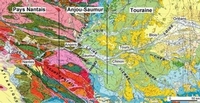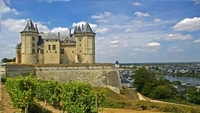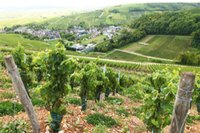 interspersed throughout a region dotted with fairytale castles, grand chateaux of the Renaissance, as well as dwellings cut into chalky riverside cliffs.
interspersed throughout a region dotted with fairytale castles, grand chateaux of the Renaissance, as well as dwellings cut into chalky riverside cliffs.
The mouth of the river, where the Loire flows into the Atlantic Ocean, is the region of Brittany. The oldest rocks in the Loire Valley are exposed here. Some 350 million years ago, there was a mountain range known to geologists as the Hercynian. Now only the roots of the mountains are left after a long period of erosion. This is the home of Muscadet, one of the most refreshing of all white wines. Muscadet is a fresh, crisp, lively and lemony wine that is a perfect match for fresh fish and shellfish. The best Muscadets are usually made by a method known as sur lie (on the lees) aging. Aging on the spent yeast cells adds a dollop of richness to this delicate wine. Consequently, the wines are imbued with a delicate, fresh-bread-yeasty complexity to the aromas and flavors. The new Cru villages of the appellation have generated new interest in Muscadet. Names like Clisson, Gorges and Le Pallet are already appearing in the market and there are more to come. The new Crus have been designated after a careful study of the local geology and their boundaries are set according to the underlying rocks. Muscadets to date have been labeled simply Muscadet, Muscadet de Coteaux de la Loire, Muscadet de Sèvre et Maine, or Muscadet Côtes de Grand Lieu, depending on its area of origin. Going forward, there will be greater interest in the true terroir of the region.
Moving upriver, we come to the Anjou-Saumur region. The geology in the region transitions from the ancient crystalline rocks of Hercynian age to much  younger sedimentary rocks deposited in shallow seas. The sandy chalks provide a very different growing environment for Loire vintners. The Chenin Blanc grape is the dominant white wine grape here for white wines, providing the basis for excellent dry, sweet and sparkling versions. The vineyards around the village of Savennières are on the old rocks and yield dry Chenin Blancs of great dimension, complexity and longevity. Two specific sites give the best wines — La Coulée de Serrant and La Roche aux Moines. These wines are rare but worth seeking out by those who want to taste perhaps the world’s greatest expression of the Chenin Blanc grape. Given 5-10 years of age, a fine Savennières blossoms into an intensely aromatic and flavorful wine laden with apple, honey and expressive floral scents.
younger sedimentary rocks deposited in shallow seas. The sandy chalks provide a very different growing environment for Loire vintners. The Chenin Blanc grape is the dominant white wine grape here for white wines, providing the basis for excellent dry, sweet and sparkling versions. The vineyards around the village of Savennières are on the old rocks and yield dry Chenin Blancs of great dimension, complexity and longevity. Two specific sites give the best wines — La Coulée de Serrant and La Roche aux Moines. These wines are rare but worth seeking out by those who want to taste perhaps the world’s greatest expression of the Chenin Blanc grape. Given 5-10 years of age, a fine Savennières blossoms into an intensely aromatic and flavorful wine laden with apple, honey and expressive floral scents.
Also on the old rocks are villages that are most famous for sweet wines. The wonderful sensory expression provided by the Chenin Blanc takes on even more intensity when the grapes are left on the vines to develop the degree of ripeness necessary for dessert wine production. Two parallel tributaries of the Loire — the River Layon and the River Aubance, provide microclimates conducive to the production of great, yet unheralded, dessert wines. The Coteaux du Layon and Coteaux de l’Aubance appellations are for sweet wines of the Chenin Blanc, with the Coteaux du Layon generally accepted as the better of the two. Bonnezeaux and Quarts de Chaume are two small vineyards in the Layon that are singled out for their superior quality and are well worth their extra price. The best Layon dessert wines have astonishingly long-life spans. Most require a decade to reach their best drinking and many are capable of lasting 30-50 years!
Saumur is a village somewhat south of the others, although still within Anjou, that is famed for its crisp, dry and bracing sparkling wines made in the classic methode traditionelle. Saumur Chenin is grown on the younger rocks of the region. The sandy chalks of Cretaceous age yield wines that are light and tart – perfect for sparkling wine production. The somewhat sandier soils in Champigny yield the lively red wines of Cabernet Franc grapes.
Moving upstream into Touraine, we have transitioned entirely to younger rocks. Near the confluence of the Vienne and the Loire are the vineyards of the Loire’s finest reds – the Cabernet Franc-based wines of Chinon and Bourgueil. At their best, these reds are supple, smooth, aromatic and refreshing. Chinon vines are on the chalky slopes along the Vienne. Bourgueil lies to the north and is largely underpinned by an old river terrace with well-drained gravelly soils. Both wines will please your palate with a combination of cherry, strawberry, raspberry and herbal nuances that is unique in the wine world. Vouvray is the famous white wine of the Touraine, grown on soft, sandy limestone locally known as tuffeau. The classic appley and floral bouquet of the Chenin Blanc takes on a distinctive and attractive earthy nuance when grown on the chalky soils of Vouvray. When made in the classic manner, good Vouvray is also capable of improving with extended age, sometimes for decades. Chenin Blanc-based sweet wines and sparkling wines are also made in Vouvray as well as the neighboring village of Montlouis. The Sauvignon Blanc grape is also planted in Touraine and makes a crisp, flinty, and usually quite affordable wine usually labeled Sauvignon de Touraine.
Moving further eastward toward the source of the Loire, we come to the famous vineyards of Sancerre and Pouilly-Fumé. The geology changes significantly here as well as the favored grape varieties. Here we are on Jurassic limestone ridges of Kimmeridigian age on the south side of the Paris Basin. Sauvignon Blanc is the dominant white grape, yielding some of the  most distinctive white wines in the world – as well as some of the most profound and satisfying companions for fresh shrimp, crab of other shellfish. The smoky/herbal/flinty cachet of the Sauvignon Blanc grape is at its most pronounced in these wines. Sancerre and Pouilly Fumé are also classic companions for the pungent goat cheeses of the region. Grilled chèvre and Sancerre is a stellar combination – one that every lover of fine food and wine should experience. Of special note are the wines from the hamlet of Chavignol, situated on a steep hillside within the Sancerre appellation. Here the Kimmeridgian limestones are well exposed as the Loire has eroded its way through the rocks. Chavignol wines capture an extra measure of intensity, complexity and ageability that sets them at the top of the Sancerre appellation. Similarly-styled wines of the Sauvignon Blanc grape can be found at friendlier prices from the nearby villages of Reuilly, Quincy, and Menetou-Salon.
most distinctive white wines in the world – as well as some of the most profound and satisfying companions for fresh shrimp, crab of other shellfish. The smoky/herbal/flinty cachet of the Sauvignon Blanc grape is at its most pronounced in these wines. Sancerre and Pouilly Fumé are also classic companions for the pungent goat cheeses of the region. Grilled chèvre and Sancerre is a stellar combination – one that every lover of fine food and wine should experience. Of special note are the wines from the hamlet of Chavignol, situated on a steep hillside within the Sancerre appellation. Here the Kimmeridgian limestones are well exposed as the Loire has eroded its way through the rocks. Chavignol wines capture an extra measure of intensity, complexity and ageability that sets them at the top of the Sancerre appellation. Similarly-styled wines of the Sauvignon Blanc grape can be found at friendlier prices from the nearby villages of Reuilly, Quincy, and Menetou-Salon.
That completes this geologic overview of the Loire, but there is much more than this to discover. The wines of Jasnières, Pouilly-sur-Loire, St. Pourçain, Haut-Poitou, Cheverny, Coteaux d’Ancenis and the Côte Roannaises are all part of the Loire’s vinous landscape. These, among many others, are Loire wines that show the distinction of their respective origins, and are wonderful food companions. Sample a Loire white or red and revel in the wines of the “Garden of France.”
